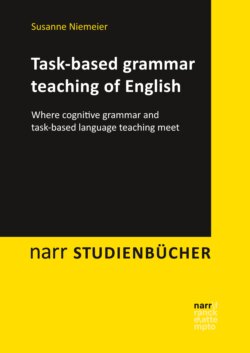Читать книгу Task-based grammar teaching of English - Susanne Niemeier - Страница 15
На сайте Литреса книга снята с продажи.
2.2.1 Pre-task
ОглавлениеThe task cycle begins with the pre-task phase, which is normally the shortest of the three stages. It has several important functions: on the one hand, it is meant to reactivate useful vocabulary or turns of phrases and to allow as many learners as possible to already say something in the foreign language, and on the other hand, it introduces the learners to the communicative topic of the lesson, which should motivate them1 and in an ideal case should be drawing on their background knowledge. If, for example, the topic relates to healthy nourishment, the teacher can start the lesson by telling the learners that s/he does not feel well because the night before s/he ate too many unhealthy products for dinner and can continue by asking the learners for alternative food suggestions, drawing on their world knowledge and at the same time on their knowledge of food vocabulary. The learners’ suggestions, presumably words for fruits and vegetables, can be collected on the board or on flashcards and can later on be consulted by the learners during the task phase.
Concerning grammar, the topic ‘healthy food’ is well-suited for introducing the plural –s, as fruits or vegetables can either be mentioned in the singular or in the plural. If the learners did not yet have any conscious contact with pluralization and answer the teacher’s question “What should I have eaten instead?” with “an apple” or “a banana”, the teacher can comment “This is true, apples/bananas are much healthier”. Thus, during the pre-task phase, the teacher should already use the grammatical structure that is to be acquired but should not expect the learners to already use it as well.
A final important function of the pre-task phase is to provide the learners with the task instructions, i.e., to introduce and explain the upcoming task and to make sure that all learners know exactly what they have to do and how much time they have to do it. Especially for lower grades, it has proven helpful to not only explain the task verbally, but to also show a slide with a step-by-step procedure and let it remain visible throughout the task, so that the learners can refer to it if necessary. Should worksheets be distributed, the step-by-step procedure can alternatively be printed on the worksheet. Also R. ELLIS (2003: 222) recommends not to rely on oral information alone: “With regard to input medium, information that is presented in written or pictorial form, which can be decoded in the learner’s own time, is likely to be easier to process than information that is provided orally, which requires online decoding”.
